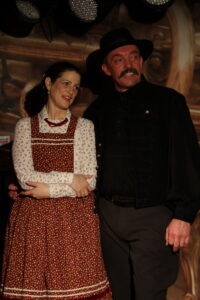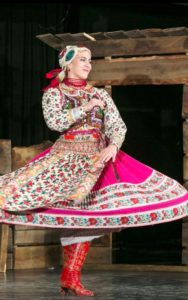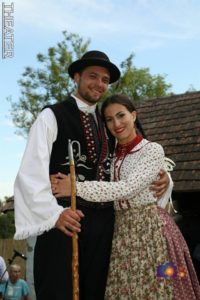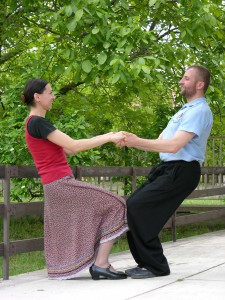Click the triangle for more details.
Norbert “Cimbi” Kovács and Beáta Gaschler
Norbert “Cimbi” Kovács is well-known in Hungary and abroad for his work preservign and promoting Hungarian cultural and folk-dance education for all ages. He started dancing at age 9 with an amateur ensemble in Ajka near his hometown of Devecser in western Hungary, and by his early twenties was artistic director of the Ajka-Padragkút Dance Group (1993-2003). He is a recipient of the Young Master of Folk Art Award (1997) and a Perpetual Golden Spur Award for solo dance (1997, 1999, 2001). He was the artistic director of the Sümeg Dance Group (2006-2012) and the Veszprém-Bakony Dance Ensemble (2012-2015).
Cimbi teaches and choreographs for groups and festivals throughout Hungary and the surrounding areas including for the Országos Táncháztalálkozó , Szezonnyitó Táncház, Forrás Néptáncegyüttes (Százhalombatta), BM Duna Művészegyüttes (Budapest), Magyar Állami Népi Együttes, and the Veszprém Táncegyüttes. He has taught internationally in Sao Paulo (Brazil), Munich (Germany), Montevideo (Uruguay), Osaka (Japan), Montreal (Canada), New Brunswick (New York), Canberra, Sydney (Australia), and at Ti Ti Tábor Camp (North America) from 2009-2014. He has served on folk dance juries for festivals such as the National Youth Solo Dance Competition, National Solo Dance Competition for adults, the South American Hungarian Folk Dance Festival, the Western Canadian Folk Dance Festival, and the Western-European Hungarian Folk Dance Meeting.
In 2003 Cimbi founded The Élő Forrás Tradition Preservation Association and serves as its president. With the association he has developed his village, Kiscsós, into a center for folk art and education and organizes and conducts folk dance camps such as the Dűvő International Folk Music Camp and many teacher training events. The Association also sponsors cultural events such as the Somló Voice Festival and the Kiscsószi Barn Festival and networks with Hungarian folk organizations in other countries through a website: www.hidakforum.hu. The Association’s “Bridges” program fosters relationships with Hungarian folk dancers of Canada, America, Austria, Slovenia (Muravidék), Slovakia (Csallóköz), Romania (Transylvania), Serbia (Vojdaság) and Germany.
In 2014, Cimbi founded the Zoltán Balla Elmentary Art School that teaches folk art to 400 children in Devecser area schools. He also founded the Élő Forrás Hagyományfalu (an interactive village museum) and the Hunyor Népfőiskola alapítója (folk college) to promote not only the cultural life in Kiscsós, but economic development as well.
In recognition of his more than two decades of work preserving folk traditions, he has received many awards: the Aprodja Award of Hungarian Culture, the Hungarian Silver Cross of Merit award (2012), the Veszprém County Prime Award, the Mediawave Award for Parallel Culture (2015), the Knight of Hungarian Culture award (2017), and the Miklós Bán award.
Beáta Gaschler began dancing at a young age and studied with various dance groups of Ajka in western Hungary. Having earned a degree in Folk Dance Pedagogy from the Hungarian Academy of Dance, Bea is currently completing a master’s degree in teaching at the Academy.
In addition to her professional studies, Bea has extensive leadership experience with performing groups. She was the women’s leader for the Apte Dance Ensemble, the Sümeg Folk Dance Ensemble, and the Veszprém-Bakony Dance Ensemble. In 2008, Bea began work as a dance teacher for the Magyarpolány Elementary Art Education Institute. Since 2014, she has been a folk-dance teacher for the Zoltán Balla Elementary Art School and an artistic director of the Bozót Folk Dance Ensemble, the Rekettye Folk Dance Ensemble, and the Kiscsőszi Talent Group. She has also received the Sirítő award for solo dancing.
Bea is the program director with the Élő Forrás Preservation Association, based in the village of Kiscsősz, where she organizes and implements community and professional programs in the village and throughout Hungary. She has traveled the world to places such as Germany, Austria and Taiwan, teaching Hungarian folk dance with her husband, Cimbi. Bea previously taught at Ti Ti Tábor from 2011-2014. Bea resides in Kiscsősz with her husband, Cimbi, and their four children.
Gábor Norbert Kovács and Nóra Kovács-Gál
Gábor Norbert Kovács entered this world in Ajka (western Hungary) as the son of folk dancer parents. As a child, he began dancing in the town his birth, ultimately graduating from the Magyar Táncművészeti Főiskola (Hungarian Dance Academy) in the program for folk dance and theater dance. After his graduation, along with his activity as a dancer he has been involved in teaching folk dance in schools. He is currently a dancer in the Magyar Nemzeti Táncegyüttes (Hungarian National Dance Ensemble).
In 2013, he received recognition as a ‘Golden Spur Dancer’ at the Békéscsabai Országos Szólótáncfesztivál (The National Solo Dance Festival in Békéscsaba).
Nóra Gál danced in various amateur ensembles from childhood. As a young person, she danced in the Bocskai Néptáncegyüttes (eastern Hungary), as a university student, in the Szentendre Táncegyüttes, then for a year as a professional dancer in the Magyar Nemzeti Táncegyüttes (Hungarian National Dance Ensemble).
She has had an opportunity to work with many Hungarian and foreign folk dance ensembles (London, Melbourne, Erdély, Vajdaság, for example) in which capacity she was awarded recognition for choreography (Martin György Országos Néptáncfesztivál 2015, Kállai Kettős Néptáncfesztivál 2016). In 2017, at the Nemzetközi Párostánc competition (International Couples’ Dance Competition), she was recognized as “Az év páros táncosa” (The Couples’ Dancer of the Year).
Currently they both work in Budapest, forming a partnership in life and in dance.
István (Pisti) Kis and Erika Kis Demeter
Born in Transylvania, István (Pisti) Kis grew up in the authentic environment of Magyarlapád. From 1995 through 2004, he worked as a professional dancer of the Háromszék Ensemble. István regularly teaches and choreographs at various schools, amateur groups, and camps, including Magyarlapád, Kommandó, Erdővidék, Szászcsávás, and Csipke folk dance camps. He has won various awards, including first and second place at the International Legényes Competition with the Magyarózd and Méra pontozós. In 2004, István earned the prestigious Young Master of Folk Art award from the Hungarian government. He has studied folk dance teaching at the College of Performing Arts in Budapest. Since 2005, he has been the artistic director of the 130 member Bem Ensemble. He married his wife, Erika Kis Demeter in a traditional wedding in Magyarlapád, which was aired on Hungarian TV. He and Erika have three beautiful daughters.Read Istvan’s detailed resume in Hungarian here
A native of Transylvania, Erika Kis Demeter has taught folk dancing and arts at various elementary schools in Romania and Hungary. In Romania she pioneered the concept of incorporating folk dancing and games into school curriculums. Erika has taught various folk dance camps including Magyarlapád, Kommandó, and Erdővidék. She was assistant artistic director at the Barót Erdővidék folk dance group and specialized in collecting authentic traditions from Erdővidék. She also earned a two-year folk dance teaching degree from the Romanian-Hungarian Dance Association. She is currently a student at the College of Performing Arts in Budapest, Erika has been a partner to her husband, Kis István not only in personal but also in professional life.Read Erika’s detailed resume in Hungarian here
Szilárd (Sziszi) Szabó and Ildikó Németh
Szilárd (Sziszi) Szabó and Ildikó Németh are well-respected dance instructors both in Hungary and throughout the folk dance world. Ildikó started out as a professional dancer and women’s leader with the Hungarian State Folk Ensemble. Sziszi danced with the Bartók,
Kodály Kamara, and Téka dance groups. Both Sziszi and Ildikó earned a folk dance teaching degree and held artistic director positions with various ensembles, including Martonvásári Százszorszép, Bartók, and Pozsonyi Szőttes. They taught at the Liszt Ferenc Music Art University, the highest level music institution in Hungary. They regularly teach at several camps, including Széki, Jászberényi, and Kiscsőszi Pajtafesztivál. Watch them!
László Tihanyi
In 2022 László Tihanyi returned for his fifth year at camp and third year teaching beginner dance classes. He is a native of Hungary and since moving to the US has resided in Oakland, California where he was Assistant Artistic Director and Principal Dancer of Eszterlanc Hungarian Folk Dance Ensemble. His background as an amateur Hungarian folk dancer and dance teacher has led the group to invite him from Hungary for leadership and teaching roles in the US. László received his Bachelor of Science in Hungarian folk dancing and folk dance coaching from the Dance Academy Budapest, Hungary. He currently resides in Ohio.
Dóra Szőke
I was born in Kecskemét on November 16, 1982. The love of movement and music has been part of my life since I was a small child. From the age of five, I attended musical physical activity classes. When I was seven, I moved into jazz ballet classes, taught by the famous and esteemed Ildikó Huszár and Atttila Varga. From the age of twelve, I studied and came to love folk traditions and folk dance as a member of the Kecskemét Dance Ensemble, officially recognized since 1998 for its high quality.
As a young adult, I became one of its mature dancers. During the fourteen years I was with the ensemble, I learned a great deal as a person and as a dancer from the ensemble’s directors, Rita Szabó Bedőcsné and József Bedőcs and, alternating with them, from Eszter Haránt Lukácsné and László Lukács (who were with the Hungarian State Folk Ensemble for many years and who won the distinction of Young Masters of Folk Arts). After graduating from the Higher Education Department of the Kecskemét University and while completing studies in the teaching of dance at the Hungarian Conservatory of Dance, I had an opportunity to teach folk dance to a children’s group that served as a preparatory or feeder ensemble in the Art School of the Ferenc Erdei Cultural Center.
From 2005 onward, I taught a year at the Kiskun Institute of Basic Art Education and served three years as artistic director of the Kadarka Folk Dance Ensemble in Cserkeszőlő. Seeking further challenges, I won acceptance to the internationally recognized Budapest Dance Ensemble in 2006 and was able to develop further under the guidance of Zoltán Zsuráfszky. I continued my professional dance career in 2007 in the Duna Art Ensemble. I owe much gratitude to Katalin Bonifert, Zsolt Juhász, and László Vámos because, along with experience in folk arts, I was able to gain enormous experience in theatrical presentation during my seven years there. Then I felt that the time has come that I should return to my original goal of teaching folk dance, armed, so to speak, with considerable experience and with new dance material. Thus, I came to the Péter Vermesy Art School in Maglód where I have been teaching for the past three years.
My goal is to transmit the knowledge, the experience, and the joy I have gained not only to the children of Maglód, but, as opportunity may present itself, to give to other children and to adults something from my creative side by way of new choreographies and performances with my colleagues and my students for our pleasure and that of our audience.
Anikó Balássy
Anikó Balássy graduated from the folk-dance department of the Hungarian Dance University (Magyar Táncművészeti Egyetem) with a degree in pedagogy. Between 1987 and 2006 she danced in the Honvéd Ensemble (today’s Hungarian National Dance Ensemble). After completing her professional dance career, she taught at an elementary school for the arts in Kispest and at the Hungarian Dance University.
Anikó has been living in Cleveland since 2018 and educating and mentoring young people in the folk-dance community there.
Viktoria Kovács
Viktoria Kovács was born and raised in Szeged, Hungary. She started dancing ballet at the age of 5 until she immigrated to the United States with her family at the age of 15. Dancing was everything to her, so she felt very lost here until the San Francisco based Eszterlanc Hungarian Folk Ensemble started up again in 1999 when she joined. She was already in love with Hungarian folk dance since at an early age she attended dance practices with her mother who was a dancer in a Hungarian folk dance group for 20 years in Szeged, Hungary. Hungarian folk dancing gave Viktoria her identity back as a dancer and as a Hungarian living in the United States. In 2004, she became the artistic and costume director of the group until 2016 when she left for maternity leave. Throughout her 12 years as artistic director she attended dance camps, workshops and festivals to bring in new material to the group and to further her knowledge in Hungarian folk dance and culture. She has rejoined the group recently as artistic director with László Tihanyi and as the costume director.
Keeping Eszterlanc Hungarian folk dance ensemble alive is vital to her as she would like to pass on everything she has learned to the future generations, including her daughter.
Anastasia Herold
Anastasia Herold began learning Hungarian folk dance as a child from her mother. She received a Master of Arts in Dance Ethnology from UCLA in 1997. From 1992-1998, she was a member of Kárpátok in Los Angeles and was company manager for two years. When she moved to San Francisco, she and local community members helped to restart Eszterlánc Hungarian Folk Ensemble and continued to be active until 2009. She recently joined the group for its 40th anniversary concert in 2017. Anastasia is a music educator and has three children.
Attila Ciceri
I began dancing with Szeged Táncegyüttes in 2000. That is where I became familiar with the fundamentals of folk dance and Hungarian folk culture. I performed at multiple Hungarian festivals and competitions with the group and took part in several international dance festivals and tours abroad. I also danced in the Szeged Táncegyüttes and Duna Művészegyüttes’s collaboration called Tavaszi szél és Aranyág (Spring Breeze and Golden Branch) and performed in the the Hungarian Folk Dance Ensemble’s production of Édeskeserű (“sweet and bitter”). Dóra Jávorszky and I have danced in the same group since 2008. Over the years, we began teaching together as well. Since 2012, we have taught multiple groups, choreographed, and instructed at dance camps. Dori and I would like to take advantage of every opportunity to nurture and pass on our culture. It is important to us that, along with teaching children and adults, we further our own skills by regularly participating in Transylvanian dance camps.
Dóra (Dóri) Jávorszky
As a young child, I had a window into the world of the dance-house by way of my older brother who is a musician. I began folk dance in 2004, then, from 2009 on, I continued in the Szeged Dance Ensemble. In the ensemble, we frequently did smaller and bigger performances and went to festivals and competitions. Sometimes I had the good fortune to do performance tours abroad and to participate in international folk dance festivals.
At present, I’m a member of the advanced troupe of the Folk Dance Ensemble of the Technical University in Budapest. I’ve danced with Attila Cicieri for nearly 10 years. For the past five years, we’ve taught children and adults, prepared choreographies, and taught at dance camps.
Along with folk dance, I’m open to many an art form. I was a student at the Szeged Free Waldorf School for thirteen years, where I was fortunate to try other forms of art. Because I hold dance to be a very important source of pleasure and joy, I’d like to ensure others, regardless of their nationality, the opportunity to become acquainted with the treasures of Hungarian dance.


















